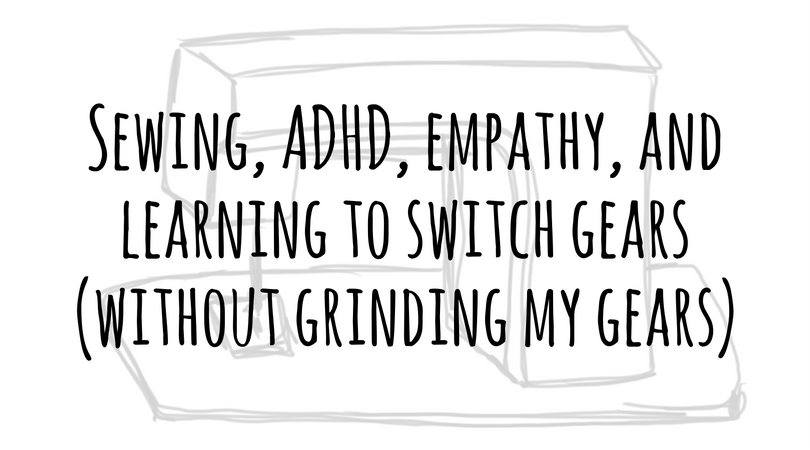My husband and I inhabit opposite ends of the ADHD spectrum, and we sometimes clash over each other’s use of personal and project time around the house. I’ve tried to develop empathy and understanding for his work style, but it’s hard, especially when my own ADHD hinders that empathetic response. I’ve learned the most — and gained the most empathy — from a hobby I’m shocked to have in the first place: sewing.

A little background on what makes time management a thorny issue for us: My focus ping-pongs between tasks. I love starting new projects. Anyone who shares an office with me will notice, I have a habit of saying a sentence or two every few minutes. This drives my husband crazy.
He finds interruptions unbearable. Once interrupted, he spends a lot of energy sinking back into his task. My multi-tasking, over-ambitious nature aggravates and overwhelms him. He only wants to work on one thing at once. Once he’s in the zone, he finds it nearly impossible to break away. He can agree the task sin’t worth the time, isn’t a priority, should at least be delayed for the sake of family time, sleep, or food — but he’ll still spend an entire day on it. I can’t spend an entire day on one thing, even if I want to.
In short: we have two very different brains. We both have ADHD, but we struggle to regulate our focus in different ways.
An unlikely truce with the sewing machine.
Until my late 20s, I avoided the sewing machine. It required many things I lacked: Focus. An ability to read directions without missing a step. A light touch. Patience. Willingness to forgo ill-advised shortcuts. My sewing projects ended one of two ways: Abandoned due to some mishap (see above) or looking uncharmingly homemade.
Then something happened. First, I started treating my ADHD. My house also needed curtains, and I had trouble finding the right size and color in the store. Curtains felt expensive for their quality. If I wanted the right stuff, I’d have to make it myself.
From curtains grew a desire to make clothing, floor cushions (another item I considered overpriced), and a weighted therapy blanket. With each project, I learned new tricks, new skills.
An object lesson in hyperfocus.
I also noticed something happening in my brain. I got into the zone with sewing in a way I usually found impossible. I’d finish a seam and want to sew up one more raw edge, and then one more. As the finished product grew nearer, I found it harder to put it down.
I mentioned this to my husband and he said, that’s exactly what software engineering is, except there’s always one more raw edge.
It’s the kind of thing that can become an addiction for a person with ADHD — especially one who struggles with controlling hyperfocus and switching tasks. With each raw edge that disappears, our brains get another little hit of dopamine. With that, we’re already chasing the next.
Brains out of (and back in) the corral.
Regardless of whether it contributes to an ADHD superpower, I don’t think hyperfocus feels good. Sure, my husband likes writing software, but he doesn’t like staying at work all night. Once the spell is broken, he won’t defend his decision to sink hours into a Wikipedia rabbit hole. In fact, it hardly feels like a decision at all. Hyperfocus can feel like a superhuman skill, but at some level, we also know we’re out of control.
My new sewing habit helped me understand and develop compassion for my husband, but I used it to teach my brain new tricks, too. I stopped and considered how long I might like to spend on sewing before I sat down at the machine. I forced myself to stop after that time had elapsed, even if my brain screamed in protest. When I burned out on a writing project, I drifted to my sewing table. Switching to a spacial, manual task allowed the linguistic part of my brain to recharge. It gave me time to decompress and allow new ideas to bubble to the surface. After a lifetime of trying to corral my focus, I learned that switching gears — done wisely — can be a good thing.
It’s easy to give up on ourselves in certain respects: to say, “my ADHD makes me bad at that.” It’s even easier to get angry with a spouse because we feel they don’t get it, aren’t trying hard enough, or just don’t care how their behavior affects us. To my surprise, sewing has taught me a lot on both fronts. I conquered a previously unconquerable skill, and I got a taste of what hyperfocusers are up against.
When do you struggle most to empathize with your partner? What helps you see the world from their perspective?
Hey there! Are you enjoying The ADHD Homestead?
Here's the thing: I don't like ads. I don't want to sell your attention to an advertising service run by the world's biggest data mining company. I also value my integrity and my readers' trust above all, which means I accept very few sponsorships/partnerships.
So I'm asking for your support directly. For the cost of one cup of coffee, you can help keep this site unbiased and ad-free.
Below you will find two buttons. The first lets you join our crew of Patreon pals and pledge monthly support for my work. Patrons also have access to my Audioblogs podcast. The second takes you to a simple donation page to pledge one-time or recurring support for The ADHD Homestead, no frills, no strings. Do whichever feels best for you!

